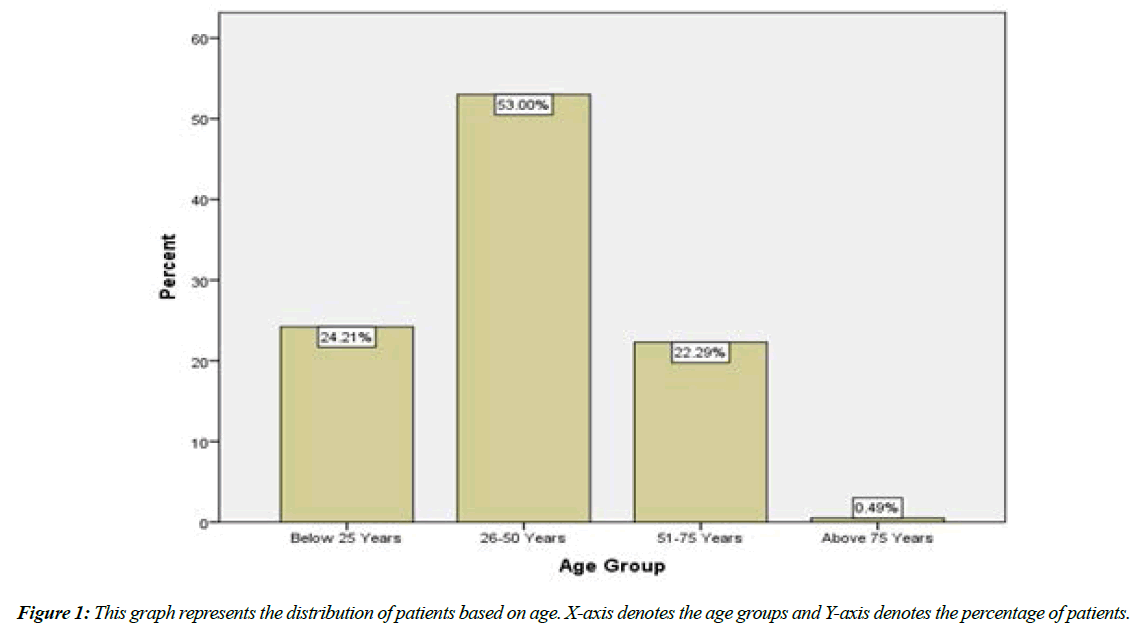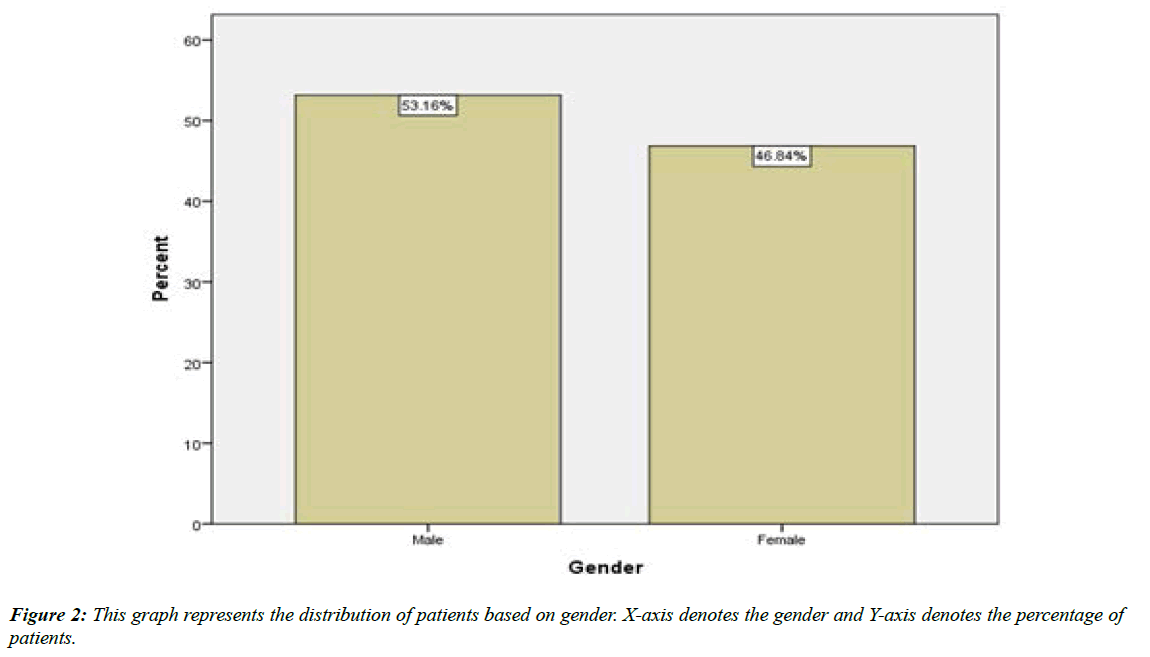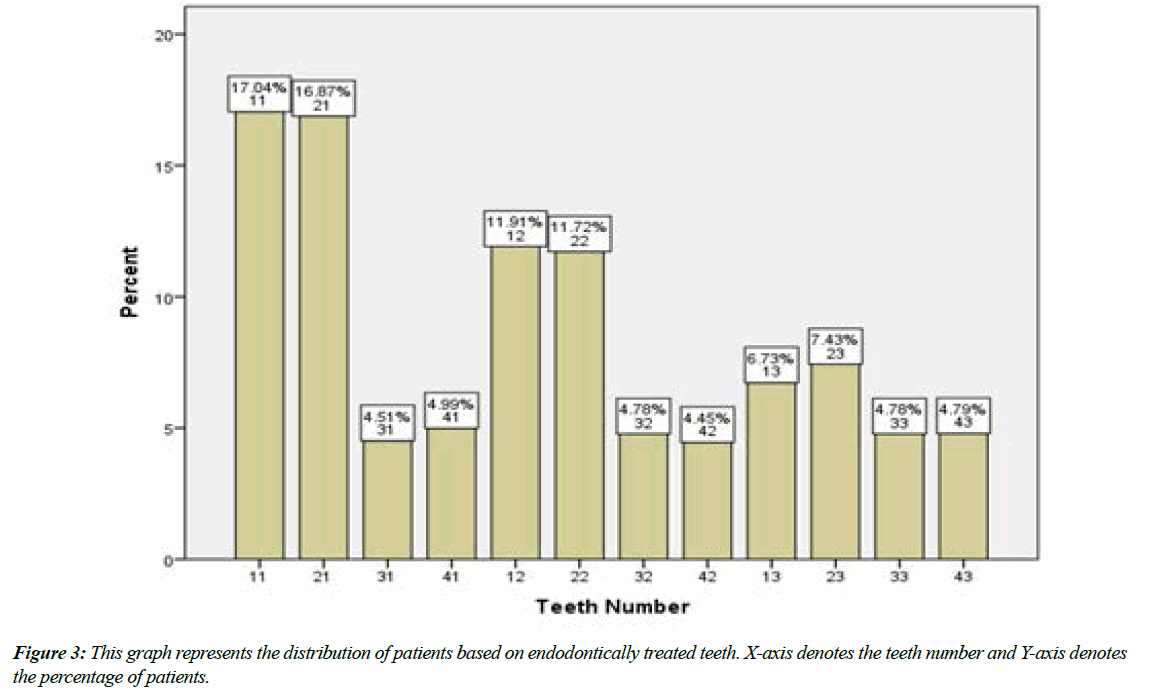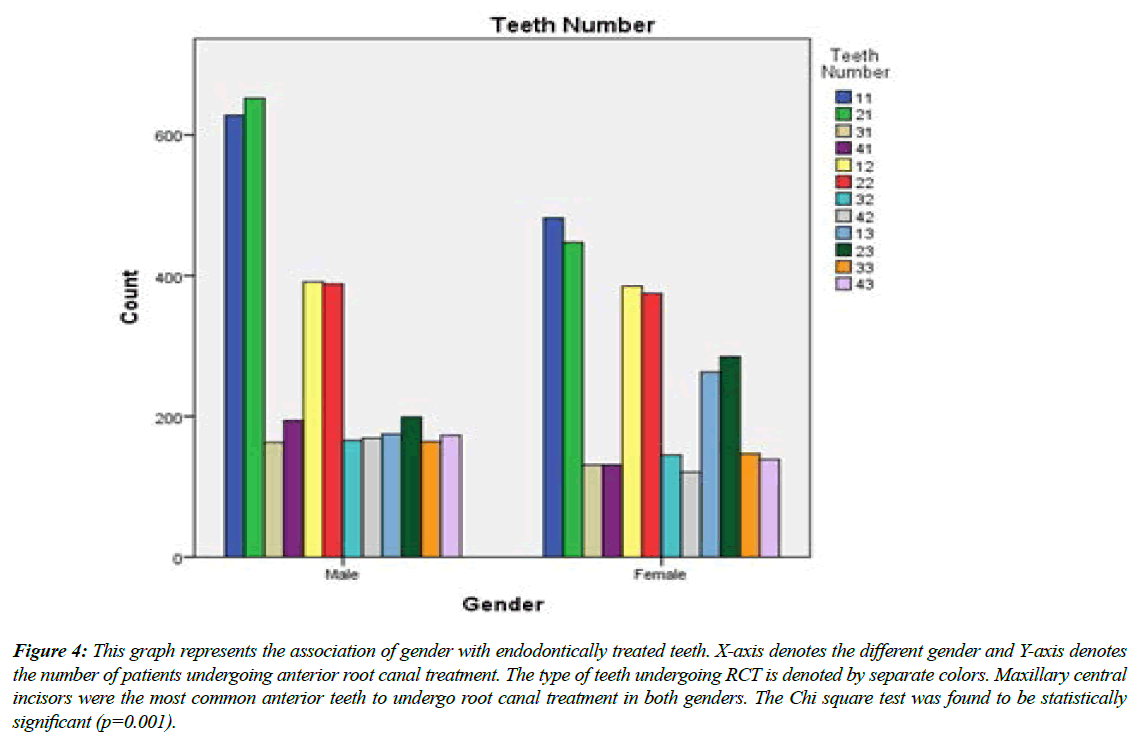Research Article - Journal of Clinical Dentistry and Oral Health (2022) Volume 6, Issue 2
Incidence of root canal treatment in anterior teeth and its association with the gender-A retrospective study
Jain A, Anjaneyulu*
Department of Aesthetic Dentistry, Saveetha Dental College, Saveetha University, Saveetha Institute of Medical and Technical Sciences, Chennai, Tamil Nadu, India
- *Corresponding Author:
- Anjaneyulu
Department of Aesthetic Dentistry
Saveetha Dental College
Saveetha Institute of Medical and Technical Sciences
Chennai, Tamil Nadu, India
E-mail: kanjaneyulu.sdc@saveetha.com
Received: 02-Mar-2022, Manuscript No. AACDOH-22-60796; Editor assigned: 04-Mar-2022, PreQC No. AACDOH-22-60796(PQ); Reviewed: 10-Mar-2022, QC No. AACDOH-22-60793; Revised: 21-Mar-2022, Manuscript No. AACDOH-22-60796(R); Published: 28-Mar-2022, DOI:10.35841/aacdoh-6.2.109
Citation: Jain A, Anjaneyulu. Incidence of root canal treatment in anterior teeth and its association with the gender-A retrospective study. J Clin Dentistry Oral Health. 2022;6(2):109
Abstract
Introduction: Root canal therapy is an efficacious therapeutic strategy to retain teeth with irreversible pulpal damage. Root canal treatment ensures that teeth with irreversible pulpal damage retain their functional role in the oral cavity. Hence the aim of the study is to determine the incidence of root canal treatment in anterior teeth and its association with the gender. Materials and method: The data of patients reporting to Saveetha Dental College and Hospitals was reviewed and patients with endodontically treated teeth were selected for the study. It included parameters like age, gender, and endodontically treated teeth type. Chi square tests were carried out using gender as independent variables and endodontically treated teeth number as dependent variable. The statistical analysis was done by Pearson chi square test. P value < 0.05 was considered statistically significant. Results: Majority (56%) of patients was between the age group of 26-50 years, and males (53%) had a slight predominance over females (47%). The most common anterior teeth to undergo root canal treatment were maxillary central incisors which accounted for approximately 34% of the RCTs among both genders. The Chi square test value was found to be statistically significant (0.001). Conclusion: Majority of the patients undergoing anterior root canal treatment were males, and maxillary central incisors were the most common anterior teeth to undergo root canal treatment among both the genders.
Keywords
Aesthetic, Dental caries, Endodontics, Novel technique, Pulpitis, Trauma.
Introduction
Dental caries is the most common infectious disease of childhood and adolescence and is rated the highest among dental problems [1]. Caries prevalence has increased in the last four decades [2]. If the cariogenic environment persists in the oral cavity, the newly erupted permanent teeth may get decayed [3]. Young permanent teeth have wide dentinal tubules, a large pulp chamber, and high pulp horns, shortening the distance for decay to reach the pulp [4]. If not treated early, infection of the dental pulp will eventually occur [5].
Treatment of pulpal infection in permanent teeth in children and young adults presents a unique challenge to dental clinicians [6]. Tooth preservation is the ultimate goal of modern dental care and root canal therapy (RCT) is an available, efficacious therapeutic strategy to retain teeth. Root canal treatment also known as endodontic treatment is one of the most technically demanding procedures and a very specialized aspect in restorative dentistry requiring a high level of technical skills [7]. It involves a series of steps to aid in clinical decision making. A reliable preoperative diagnosis with radiographic assessment is essential [8]. This will enable correct determination of the desired working length during canal preparation, master gutta percha and obturation. Thus many aspects of RCT such as instruments, medicaments and materials have been developed and modified. Many studies regarding cleaning and shaping techniques quoted that commonly applied techniques were step-back, crown-down and double-flare technique [9–11]. These techniques were chosen as they removed the bulk of micro-organisms which harbour at the apical area [12].
Endodontic treatment will ensure that a diseased tooth or root retains its functional role in the oral cavity [13]. The reasons for prescribing endodontic treatments are mainly related to complications of dental caries. Studies have shown that toothache and dental abscess were the commonest complaints given by patients demanding for RCT [14,15].
Since the prominent factors necessitating RCT are caries related, it is therefore not surprising to observe that the pattern of provision of RCT with respect to the teeth involved tends to follow the reported order of susceptibility of teeth to caries : mandibular second molars being the most susceptible teeth; followed by maxillary first and second molars and mandibular first molars; maxillary and mandibular second premolars; maxillary and mandibular first premolars; maxillary central and lateral incisors; and maxillary and mandibular canines, with mandibular central and lateral incisors being the least susceptible teeth [16,17].
There are limited epidemiological studies relating to the pattern of demand of RCT in India particularly in the southern part of the country. Information on reasons and patterns of demand for treatment is necessary for understanding disease patterns as well as for devising optimal preventive and management strategies.
Our team has extensive knowledge and research experience that has translate into high quality publications [18-37].
Hence the aim of this study is to determine the incidence of root canal treatment in posterior teeth and their association with gender among patients attending a private dental college and hospital in Chennai.
Materials and Methods
Study design and study setting
The present study was conducted in a university setting (Saveetha dental college and hospitals, Chennai, India). Thus the data available is of patients from the same geographic location and have similar ethnicity. The retrospective study was carried out with the help of digital case records of 6513 patients who reported to the hospital. Ethical clearance to conduct this study was obtained from the Scientific Review Board of the hospital.
Sampling
Data of 6513 patients were reviewed and then extracted. All patients with endodontically treated anterior teeth in the given duration of time period were evaluated. Only relevant data was included to minimize sampling bias. Simple random sampling method was carried out. Cross verification of data for error was done by the presence of additional reviewers and by photographic evaluation. Incomplete data collection was excluded from the study.
Data collection
A single calibrated examiner evaluated the digital case records of patients who reported to Saveetha Dental College from June 2019 to June 2021. For the present study, inclusion criteria were data of patients with endodontically treated anterior teeth. Data obtained were age, gender and endodontically treated teeth number. All obtained data were tabulated into Microsoft excel documents.
Statistical analysis
The collected data was tabulated and analyzed with Statistical Package for Social Sciences for Windows, version 20.0 (SPSS Inc., Vancouver style) and results were obtained. Categorical variables were expressed in frequency and percentage. Chi square test was used to test association between categorical variables. Chi square tests were carried out using gender as an independent variable and endodontically treated teeth number as a dependent variable. The statistical analysis was done by pearson chi square test. P value < 0.05 was considered statistically significant.
Results
In our study, the majority (53%) of the patients undergoing anterior root canal treatment were between 26-50 years of age (Figure 1).
Males had a slight predominance (53%) undergoing anterior root canal treatment over females (47%) (Figure 2).
Maxillary central incisors (34%) were the most common anterior teeth to undergo root canal treatment, followed by maxillary lateral incisors (23%) (Figure 3).
On associating gender with the teeth number, maxillary central incisors were the most common anterior teeth to undergo root canal treatment in both genders. The Chi square value was found to be statistically significant (0.001) (Figure 4).
Figure 4: This graph represents the association of gender with endodontically treated teeth. X-axis denotes the different gender and Y-axis denotes the number of patients undergoing anterior root canal treatment. The type of teeth undergoing RCT is denoted by separate colors. Maxillary central incisors were the most common anterior teeth to undergo root canal treatment in both genders. The Chi square test was found to be statistically significant (p=0.001).
Discussion
Dental caries is the most common infectious disease of childhood and adolescence and is rated the highest among dental problems [1]. If not treated early, infection of the dental pulp will eventually occur [5]. Treatment of pulpal infection in permanent teeth in children and young adults presents a unique challenge to dental clinicians [6]. Tooth preservation is the ultimate goal of modern dental care and root canal therapy (RCT) is an available, efficacious therapeutic strategy to retain teeth. Root canal treatment also known as endodontic treatment is one of the most technically demanding procedures and a very specialized aspect in restorative dentistry requiring a high level of technical skills [7].
About 53% of the patients encountered in this study were males. Similar findings were recorded by Osama et al and Wayman et al in their studies [14,38]. Though most of the studies reported higher demand for endodontic treatment by female patients [39–41]. Females had been reported to be more concerned about their breath and oral health; hence they appeared to be better motivated to demand for oral health care [39, 42].
Most of the patients that presented were found in the 26-50 years age group. This can be partly attributed to the location of our hospital which is in a university environment with a huge students’ population. Another possible reason is the high prevalence of dental caries often reported among young and middle aged adults. Patients in their 3rd and 4th decades have been observed to present more for dental treatmen. Our result therefore, is in agreement with that of Farrel and Burke,[40] who showed that the highest incidence of endodontic treatment was performed among patients between 21-30 years age group.
In our study, maxillary central incisors accounted for approximately 34%, followed by maxillary lateral incisors (23%). Similar findings were reported by AL Negrish et al, and Umanah et al.
Root canal treatments were more frequently undertaken in maxillary teeth than mandibular teeth in our study. This pattern was in agreement with that of Scavo et al [43] and Al-Negrish [41] who reported that 55.69% and 77.7% of their RCTs were performed in maxillary teeth respectively.
It is probable that the following reasons are behind the high incidence of endodontically treated maxillary incisors: all incisors erupt early and so may decay early; on the other hand, the carries rate for maxillary incisors is much higher than that for the mandibular incisors which are constantly bathed in saliva.
The maxillary incisors due to their location are more susceptible to injury as compared to the rest of the teeth. In addition to the caries rate, personal aesthetic appeal could be the motivating factors for the higher incidence of root canal therapy in maxillary incisors in this study. The upper teeth appear more prominent than the lower teeth during smile, making the patient more interested in preserving the upper teeth.
This will account for a good deal of endodontic therapy in the premaxilla, likewise, large pulpal horns, which lie in a mesiodistal direction, quickly become involved by interproximal caries. All these factors combine to increase the incidence of pulpal involvement and endodontic therapy in the maxillary incisors [38-43].
Limitations of this study are smaller sample size, and geographical limitations. Further studies with larger sample size and a greater geographical aspect can help in better diagnosis and further treatment planning for endodontic treatments.
Conclusion
Majority of the patients undergoing anterior root canal treatment were males, and maxillary central incisors were the most common anterior teeth to undergo root canal treatment among both the genders.
Acknowledgement
The authors sincerely acknowledge the faculty Medical record department and Information technology department of SIMATS for their tireless help in sorting out data’s pertinent to this study.
Funding
The present project is supported/funded/sponsored by Saveetha Institute of Medical and Technical Sciences, Saveetha Dental College and Hospitals, Saveetha University contributed by Southern Engineering Co Ltd.
Conflict of Interest
None
References
- Bagramian RA, Garcia-Godoy F, Volpe AR. The global increase in dental caries. A pending public health crisis. Am J dent. 2009;22(1):3-8.
- Mortazavi M, Mesbahi M, Azar MR, et al. MTA Pulpotomy in Primary Molars, A Prospective Study. Res J Biol Sci. 2009;4(5):1-5.
- Parsell DE, Streckfus CF, Stewart BM, et al. The effect of amalgam overhangs on alveolar bone height as a function of patient age and overhang width. Oper Dent. 1998;23:94-9.
- Qualtrough AJ, Wilson NH. The history, development and use of interproximal wedges in clinical practice. Dent Update. 1991;18(2):66-70.
- Santos MJ. A restorative approach for class ii resin composite restorations: a two-year follow-up. Oper Dent. 2015;40(1):19-24.
- Wirsching E, Loomans BA, Klaiber B, et al. Influence of matrix systems on proximal contact tightness of 2-and 3-surface posterior composite restorations in vivo. J Dent. 2011;39(5):386-90.
- Quadir F, Ali Abidi SY, Ahmed S. Overhanging amalgam restorations by undergraduate students. J Coll Physicians Surg Pak. 2014;24(7):485-8.
- Burke FJ, Shortall AC. Successful restoration of load-bearing cavities in posterior teeth with direct-replacement resin-based composite. Dent Update. 2001;28(8):388-98.
- Dörfer CE, Schriever A, Heidemann D, et al. Influence of rubber-dam on the reconstruction of proximal contacts with adhesive tooth-colored restorations. J Adh Dent. 2001;3(2):169-75.
- Abrams H, Kopczyk RA. Gingival sequela from a retained piece of dental floss. J Am Dent Assoc.1983;106(1):57-8.
- Kamel JH. Retention of Posterior Composite Resin Restorations (Doctoral dissertation, University of Dundee).
- Van der Vyver PJ. Posterior composite resin restorations. Part 3. Matrix systems. SADJ. 2002;57(6):221-6.
- Muthukrishnan L. Imminent antimicrobial bioink deploying cellulose, alginate, EPS and synthetic polymers for 3D bioprinting of tissue constructs. Carbo Poly. 2021;260:117774.
- PradeepKumar AR, Shemesh H, Nivedhitha MS, et al. Diagnosis of vertical root fractures by cone-beam computed tomography in root-filled teeth with confirmation by direct visualization: a systematic review and meta-analysis. J Endo. 2021;47(8):1198-214.
- Chakraborty T, Jamal RF, Battineni G, et al. A review of prolonged post-COVID-19 symptoms and their implications on dental management. Int J Environ Res Public Health. 2021;18(10):5131.
- Muthukrishnan L. Nanotechnology for cleaner leather production: a review. Environ Chem Lett. 2021;19(3):2527-49.
- Teja KV, Ramesh S. Is a filled lateral canal–A sign of superiority?. J Dent Sci. 2020;15(4):562.
- Narendran K, MS N, Sarvanan A. Synthesis, Characterization, Free Radical Scavenging and Cytotoxic Activities of Phenylvilangin, a Substituted Dimer of Embelin. Ind J Pharmac Sci. 2020;82(5):909-12.
- Reddy P, Krithikadatta J, Srinivasan V, et al. Dental caries profile and associated risk factors among adolescent school children in an urban South-Indian city. Oral Health Prev Dent. 2020;18(1):379-86.
- Sawant K, Pawar AM, Banga KS, et al. Dentinal Microcracks after Root Canal Instrumentation Using Instruments Manufactured with Different NiTi Alloys and the SAF System: A Systematic Review. App Sci. 2021;11(11):4984.
- Bhavikatti SK, Karobari MI, Zainuddin SL, et al. Investigating the Antioxidant and Cytocompatibility of Mimusops elengi Linn Extract over Human Gingival Fibroblast Cells. Int J Enviro Res Public Hea. 2021;18(13):7162.
- Karobari MI, Basheer SN, Sayed FR, et al. An In Vitro Stereomicroscopic Evaluation of Bioactivity between Neo MTA Plus, Pro Root MTA, BIODENTINE & Glass Ionomer Cement Using Dye Penetration Method. Mat. 2021;14(12):3159.
- Rohit Singh T, Ezhilarasan D. Ethanolic extract of Lagerstroemia Speciosa (L.) Pers., induces apoptosis and cell cycle arrest in HepG2 cells. Nutr Cancer. 2020;72(1):146-56.
- Ezhilarasan D. MicroRNA interplay between hepatic stellate cell quiescence and activation. Euro J Pharmacol. 2020;885:173507.
- Romera A, Peredpaya S, Shparyk Y, et al. Bevacizumab biosimilar BEVZ92 versus reference bevacizumab in combination with FOLFOX or FOLFIRI as first-line treatment for metastatic colorectal cancer: a multicentre, open-label, randomised controlled trial. Lancet Gastroenterol Hepatol. 2018;3(12):845-55.
- Raj R K. ß-Sitosterol-assisted silver nanoparticles activates Nrf2 and triggers mitochondrial apoptosis via oxidative stress in human hepatocellular cancer cell line. J Biomed Mat Res Part A. 2020;108(9):1899-908.
- Vijayashree Priyadharsini J. In silico validation of the non-antibiotic drugs acetaminophen and ibuprofen as antibacterial agents against red complex pathogens. J Periodontol. 2019;90(12):1441-8.
- Priyadharsini JV, Girija AS, Paramasivam A. In silico analysis of virulence genes in an emerging dental pathogen A. baumannii and related species. Archiv Oral Biol. 2018;94:93-8.
- Uma Maheswari TN, Nivedhitha MS, Ramani P. Expression profile of salivary micro RNA-21 and 31 in oral potentially malignant disorders. Braz Oral Res. 2020;34.
- Gudipaneni RK, Alam MK, Patil SR, et al. Measurement of the maximum occlusal bite force and its relation to the caries spectrum of first permanent molars in early permanent dentition. J Clini Pediatr Dent. 2020;44(6):423-8.
- Chaturvedula BB, Muthukrishnan A, Bhuvaraghan A, et al. Dens invaginatus: a review and orthodontic implications. Br Dent J. 2021;230(6):345-50.
- Kanniah P, Radhamani J, Chelliah P, et al. Green synthesis of multifaceted silver nanoparticles using the flower extract of Aerva lanata and evaluation of its biological and environmental applications. Chem Select. 2020;5(7):2322-31.
- Wayman BE, Patten JA, Dazey SE. Relative frequency of teeth needing endodontic treatment in 3350 consecutive endodontic patients. J Endo. 1994;20(8):399-401.
- Hollanda AC, Alencar AH, Estrela CR, et al. Prevalence of endodontically treated teeth in a Brazilian adult population. Braz Dent J. 2008;19(4):313-7.
- Manga PR, Charette AN. The patterns and determinants of the utilization of dental care services in Canada. Can J Public Health. 1986;77:119-23.
- Boucher Y, Matossian L, Rilliard F, et al. Radiographic evaluation of the prevalence and technical quality of root canal treatment in a French subpopulation. Int Endod J. 2002 ;35(3):229-38.
- De Quadros I, Gomes BP, Zaia AA, et al. Evaluation of endodontic treatments performed by students in a Brazilian Dental School. J Dent Edu. 2005;69(10):1161-70.
- Patro BK, Kumar BR, Goswami A, et al. Prevalence of dental caries among adults and elderly in an urban resettlement colony of New Delhi. Ind J Dental Res. 2008;19(2):95.
- Oginni AO. Dental care needs and demands in patients attending the dental hospital of the Obafemi Awolowo University Teaching Hospital's Complex Ile-Ife, Nigeria. Nig J Med. 2004;13(4):339-44.
- Farrell TH, Burke FJ. Root canal treatment in the General Dental Service 1948-1987. Br Dent J. 1989;166(6):203-8.
- Al-Negrish AR. Incidence and distribution of root canal treatment in the dentition among a Jordanian sub population. Int Dent J. 2002;52(3):125-9.
- Umanah AU, Osagbemiro BB, Arigbede AO. Pattern of demand for endodontic treatment by adult patients in port-harcourt, South-South Nigeria. J West Afr Coll Surg. 2012;2(3):12.
- Scavo R, Lalis RM, Zmener O, et al. Frequency and distribution of teeth requiring endodontic therapy in an Argentine population attending a specialty clinic in endodontics. Int Dent J. 2011;61(5):257-60.
Indexed at, Google Scholar, Cross Ref
Indexed at, Google Scholar, Cross Ref
Indexed at, Google Scholar, Cross Ref
Indexed at, Google Scholar Cross Ref
Indexed at, Google Scholar, Cross Ref
Indexed at, Google Scholar, Cross Ref
Indexed at, Google Scholar, Cross Ref
Indexed at, Google Scholar, Cross Ref
Indexed at, Google Scholar, Cross Ref
Indexed at, Google Scholar, Cross Ref
Indexed at, Google Scholar, Cross Ref
Indexed at, Google Scholar, Cross Ref
Indexed at, Google Scholar, Cross Ref
Indexed at,Google Scholar, Cross Ref
Indexed at, Google Scholar, Cross Ref
Indexed at, Google Scholar, Cross Ref
Indexed at, Google Scholar, Cross Ref
Indexed at, Google Scholar, Cross Ref
Indexed at, Google Scholar, Cross Ref
Indexed at, Google Scholar, Cross Ref
Indexed at, Google Scholar, Cross Ref



